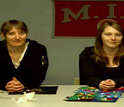News Release 10-230
NSF Celebrates Computer Science Education Week 2010
NSF-funded programs like GLITCH and E-Textiles make it cool to compute and may inspire the next Bill Gates

High-Low Tech research group seeks to engage diverse people in developing their own technologies.
December 7, 2010
View a webcast highlighting two NSF programs that engage students in computer science.
This material is available primarily for archival purposes. Telephone numbers or other contact information may be out of date; please see current contact information at media contacts.
Imagine a jacket that lights up. With directional arrows programmed into the fabric, a bicyclist can use her jacket to alert traffic when she's turning. The jacket is an example of e-textiles, a techology that is drawing more girls to computer science through an innovative program at MIT. Meanwhile at Georgia Tech, high school students are hired to test and debug computer games, a way of bringing diverse students to computer science.
These inspired programs are unfortunately not typical. American information technology and software companies dominate the world marketplace, yet there is a gaping hole in formal computer science education. For K-12 students, computer science education is practically nonexistent. The United States lacks an adequate pipeline to feed world class computer science at the university level with the number and diversity of students needed to address societal challenges.
To recognize the critical role of computing and computer science education in the 21st century, Congress declared Dec. 5-11, 2010, as Computer Science Education Week (CSEdWeek).
In a Dec. 7 webcast, the National Science Foundation (NSF) highlighted two NSF-funded programs that aim to fill this gap and engage populations of students not typically drawn to computer science.
Amy Bruckman of Georgia Tech, along with Ph.D. candidate Betsy DiSilvo and former student James Bowland-Gleason, describes GLITCH, the Georgia Tech program that uses video games as a way for the high school students to "break open" the games and look at them as a piece of technology.
Leah Buechley and Emily Lovell of MIT's Media Lab report on their success at the forefront of teaching information technologies to the next generation of female computer scientists. They discuss how their High-Low Tech research group explores the integration of high and low technology from cultural, material, and practical perspectives to engage diverse groups of people in developing their own technologies. E-Textiles at MIT, for example, has captured the imagination and honed the computational skills of girls.
CSEdWeek representative Cameron Wilson of the Association for Computer Machinery provides perspective on why this week is important to his industry and to America's competitive edge. Other countries have stepped up their efforts with computer science education, and several countries, including Canada, Israel, New Zealand, Australia and some Asian countries have implemented a comprehensive computer science curriculum.
The notion that only future computer scientists or information technology (IT) professionals need training in computer science is no longer true. Outside of the IT industry, knowledge of computer science and computer programming is becoming a necessary skill for many professions, including those in science and technology, as well as careers in marketing, advertising, journalism and the creative arts.
-NSF-
-
View Video
This webcast spotlights programs that engage a diversity of students in computer science.
Credit and Larger Version
Media Contacts
Alexandra Kahn, MIT, 617-253-0365, email: akahn@media.mit.edu
Lisa-Joy Zgorski, NSF, (703) 292-8311, email: lzgorski@nsf.gov
Michael Terrazas, Georgia Tech, (404) 385-7225, email: mterraza@cc.gatech.edu
Program Contacts
Janice Cuny, NSF, (703) 292-8900, email: jcuny@nsf.gov
Cameron Wilson, Association for Computer Machinery, (202) 659-9711, email: cameron.wilson@acm.org
Principal Investigators
Amy Bruckman, Georgia Tech, email: amy.bruckman@cc.gatech.edu
Leah Buechley, MIT Media Lab, 617-253-2870, email: leah@media.mit.edu
Related Websites
Computer Science Education Week: http://www.csedweek.org/
GLITCH: Using computer game testing to hook students: http://www.prism.gatech.edu/~tjohnson3/GlitchTest.html
Clothing Gets Computerized - About E-Textiles: http://singularityhub.com/2009/06/18/clothing-gets-computerized/
E-Textiles on YouTube: http://www.youtube.com/watch?v=NpRphKTMmKE&feature=player_embedded
Association for Computer Machinery: http://www.acm.org/
NSF Computing News: http://www.nsf.gov/news/index.jsp?prio_area=5
NSF Computer and Information Science and Engineering (CISE): http://www.nsf.gov/dir/index.jsp?org=CISE
The U.S. National Science Foundation propels the nation forward by advancing fundamental research in all fields of science and engineering. NSF supports research and people by providing facilities, instruments and funding to support their ingenuity and sustain the U.S. as a global leader in research and innovation. With a fiscal year 2023 budget of $9.5 billion, NSF funds reach all 50 states through grants to nearly 2,000 colleges, universities and institutions. Each year, NSF receives more than 40,000 competitive proposals and makes about 11,000 new awards. Those awards include support for cooperative research with industry, Arctic and Antarctic research and operations, and U.S. participation in international scientific efforts.
Connect with us online
NSF website: nsf.gov
NSF News: nsf.gov/news
For News Media: nsf.gov/news/newsroom
Statistics: nsf.gov/statistics/
Awards database: nsf.gov/awardsearch/
Follow us on social
Twitter: twitter.com/NSF
Facebook: facebook.com/US.NSF
Instagram: instagram.com/nsfgov

